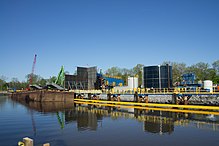Superfund
[1] The program is administered by the Environmental Protection Agency (EPA) and is designed to pay for investigating and cleaning up sites contaminated with hazardous substances.Approximately 70% of Superfund cleanup activities historically have been paid for by the potentially responsible parties (PRPs),[4] reflecting the polluter pays principle.In November 2021, the Infrastructure Investment and Jobs Act reauthorized an excise tax on chemical manufacturers, for ten years starting in July 2022.A score of 28.5 places a site on the National Priorities List, eligible for long-term, remedial action (i.e., cleanup) under the Superfund program.For the federal government, EPA,[8] US Fish and Wildlife Service,[9] or the National Oceanic and Atmospheric Administration[10] may act as natural resource trustees.[13] CERCLA was enacted by Congress in 1980 in response to the threat of hazardous waste sites, typified by the Love Canal disaster in New York, and the Valley of the Drums in Kentucky.[20][21] In 1994 President Bill Clinton issued Executive Order 12898, which called for federal agencies to make achieving environmental justice a requirement by addressing low income populations and minority populations that have experienced disproportionate adverse health and environmental effects as a result of their programs, policies, and activities.[23] Some environmentalists and industry lobbyists saw the Clinton administration's environmental justice policy as an improvement, but the order did not receive bipartisan support.The newly elected Republican Congress made numerous unsuccessful efforts to significantly weaken the program.[25] Even though by 1995 the Superfund balance had decreased to about $4 billion, Congress chose not to reauthorize collection of the tax, and by 2003 the fund was empty.[15]: 8 In November 2021, Congress reauthorized an excise tax on chemical manufacturers, under the Infrastructure Investment and Jobs Act.The 2021 law also authorized $3.5 billion in emergency appropriations from the U.S. government general fund for hazardous site cleanups in the immediate future.Four classes of PRPs may be liable for contamination at a Superfund site: The liability scheme of CERCLA changed commercial and industrial real estate, making sellers liable for contamination from past activities, meaning they can't pass liability onto unknowing buyers without any responsibility.[42] Information from the PA/SI is used by the EPA to develop a Hazard Ranking System (HRS) score to determine the CERCLA status of the site.Once the Remedial Action has been completed, reviews are required every five years, whenever hazardous substances are left onsite above levels safe for unrestricted use.In West Dallas, Texas, a mostly African American and Latino community, a lead smelter poisoned the surrounding neighborhood, elementary school, and day cares for more than five decades.It was later revealed that EPA Deputy Administrator John Hernandez had deliberately stalled the cleanup of the lead-contaminated hot spots.It was the largest radioactive spill in the US but received a long delay in government response and cleanup after being placed as a lower priority site.Two sets of five-year cleanup plans have been put in place by US Congress, but contamination from the Church Rock incident has still not been completely cleaned up.





Superfund GroupSuperfund (disambiguation)Acronyms96th United States CongressStatutes at LargeU.S.C.42 U.S.C.James FlorioHouse Interstate and Foreign CommerceHouse Ways and MeansSenate EnvironmentSenate FinanceJimmy CarterEmergency Planning and Community Right-to-Know Act of 1986Small Business Liability Relief and Brownfields Revitalization ActUnited States Supreme CourtUnited States v. BestfoodsCTS Corp. v. WaldburgerGuam v. United Statesenvironmental remediationEnvironmental Protection AgencyNew Jerseypolluter pays principleexcise taxInfrastructure Investment and Jobs ActHazard Ranking SystemAgency for Toxic Substances and Disease Registryhazmat suitsCongresshazardous wasteLove CanalNew YorkValley of the DrumsKentuckytrust fundRonald Reagan administrationAnne Gorsuch Burfordconsent decreesweetheart dealsBill ClintonExecutive Orderenvironmental justiceCapitol Hill2001 anthrax attacksObama administrationGina McCarthyHudson RiverHousatonic RiverPittsfield, MassachusettsNational Priorities ListliableresourceNational Oil and Hazardous Substances Pollution Contingency Planhazardous substancesremediationtreble damagesKin-Buc LandfillEdison, New JerseyList of Superfund sites in the United StatesDepartment of the Treasurypublic healthhazardous wastessurface watergroundwaterTriana, AlabamaWest Dallas, Texaslead smelterWarren County, North Carolinaenvironmental injusticePCB landfillBayview-Hunters Point, San Franciscoenvironmental discriminationSan Francisco Naval ShipyardChurch Rock uranium mill spillTOXMAPGeographic Information System (GIS)United States National Library of MedicineToxics Release InventoryPubMedBrownfield landFormerly Used Defense SitesHazardous Materials Transportation ActNational Oil and Hazardous Substances Contingency PlanPhase I Environmental Site AssessmentPollution40 CFR42 U.S.C.BibcodeWikisourceUnited States CodeUS House of RepresentativesUSAspending.govsites in the United StatesAlabamaAlaskaArizonaArkansasCaliforniaColoradoConnecticutDelawareFloridaGeorgiaHawaiiIllinoisIndianaKansasLouisianaMarylandMassachusettsMichiganMinnesotaMississippiMissouriMontanaNebraskaNevadaNew HampshireNew MexicoNorth CarolinaNorth DakotaOklahomaOregonPennsylvaniaRhode IslandSouth Carolina